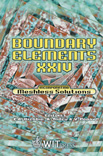The BEM Formulation Of The Distinct Element Method
Price
Free (open access)
Transaction
Volume
32
Pages
10
Published
2002
Size
658 kb
Paper DOI
10.2495/BE020271
Copyright
WIT Press
Author(s)
P Procházka
Abstract
The distinct element method consists of discretization of a continuum into particles, which maybe of different shape. One of the most prospective shape, particularly in geotechnics, is a ball in 3D, or a circle in 2D. The particles are in mutual contact and the contact is realized by springs in both normal and tangential directions. The springs express the elastic proper-ties of the material. The particles are considered to be rigid. The most complicated problem is to determine the properties of the springs. Our objective in this paper is to avoid this difficulty by solving the free hexagonal elements in 2D using the BEM. This enables one to involve plastic, viscoplastic, or other nonlinear behavior in the particles and introduction of several types of contact conditions is also possible. On the other hand the systern of algebraic equations may be enormous. Since the matrices in numerical treatment are nested, an iteration procedure can to be employed solving these equations. When formulating the problem as a nonlinear (and it is nonlinear in any case), the iteration process must be used anyway, so that the solution of the algebraic equations by iterative methods is natural. In comparison with continuum our concept leads to possibly disconnecting medium, which is the case of, e.g., soil. In our case the description of the natural conditions is more probable and faithful in comparison with the balls. Also, the contact material values are compatible with the material parameters of the medium (angle of internal friction, cohesion, modulus of elasticity, etc.). The theory is applied to constructions of underground works, namely excavation of long wall mines in great depths, i.e., particularly to mining engineering and brittle material of strongly compressed rock (coal).
Keywords





